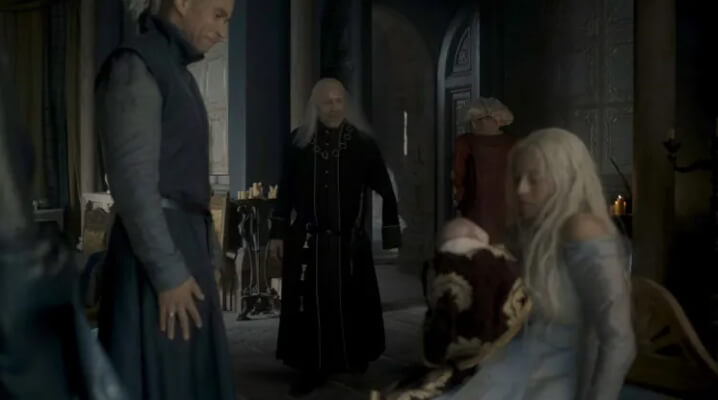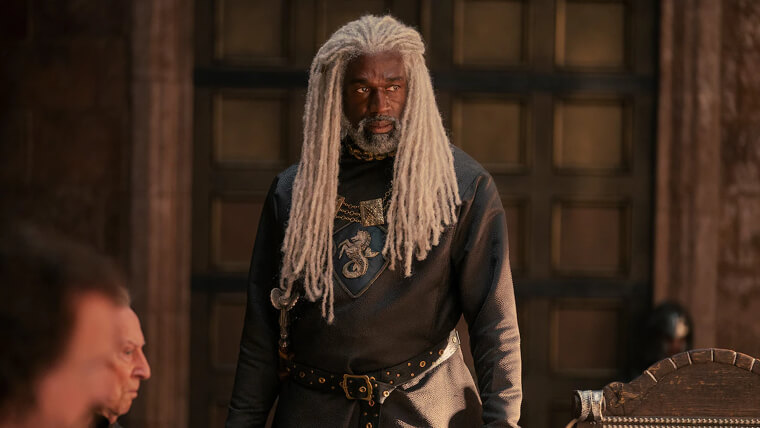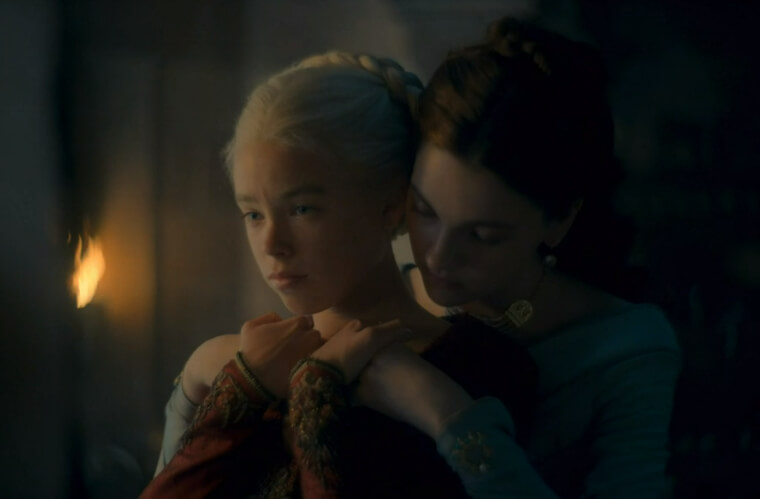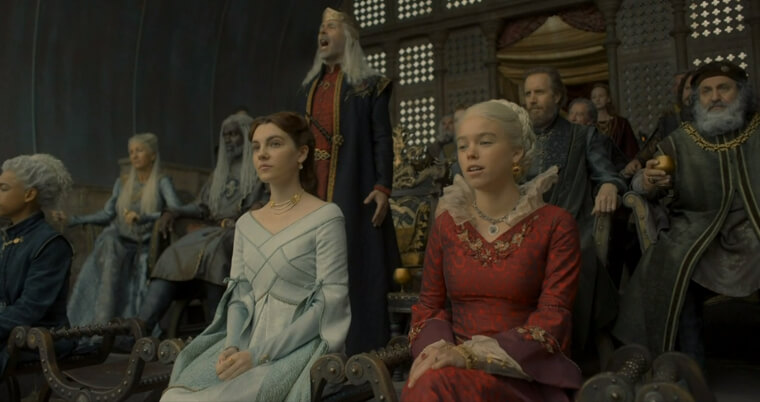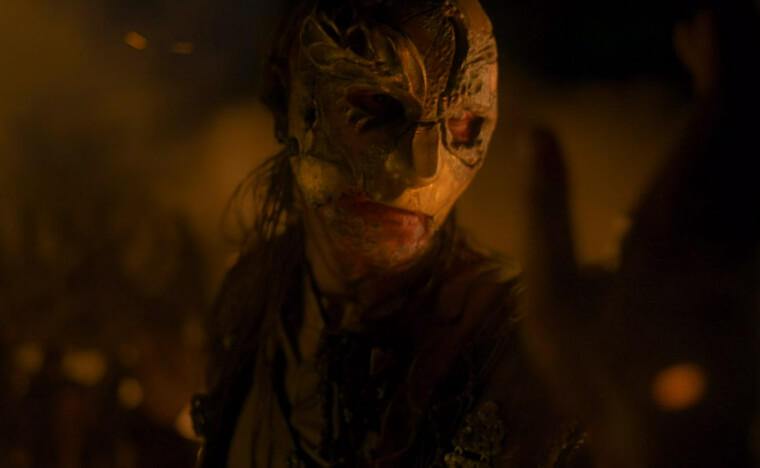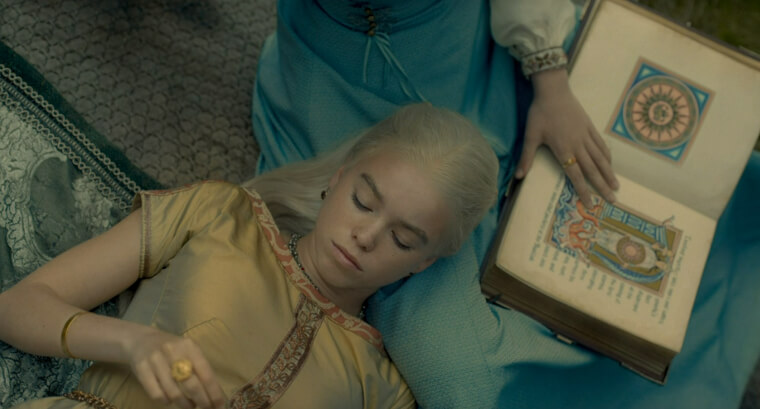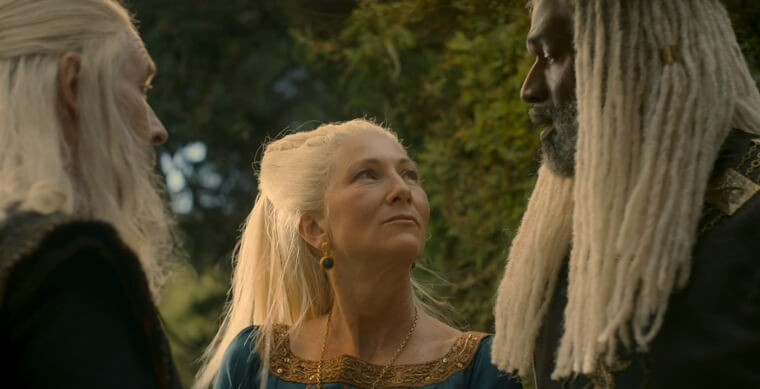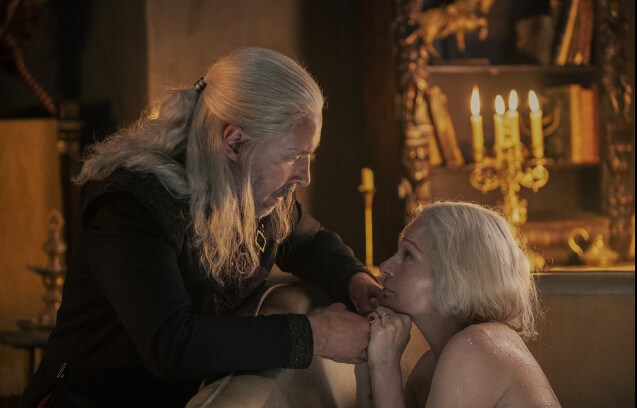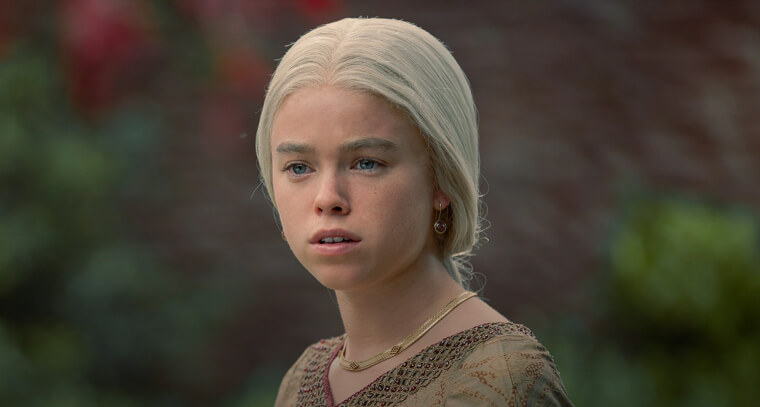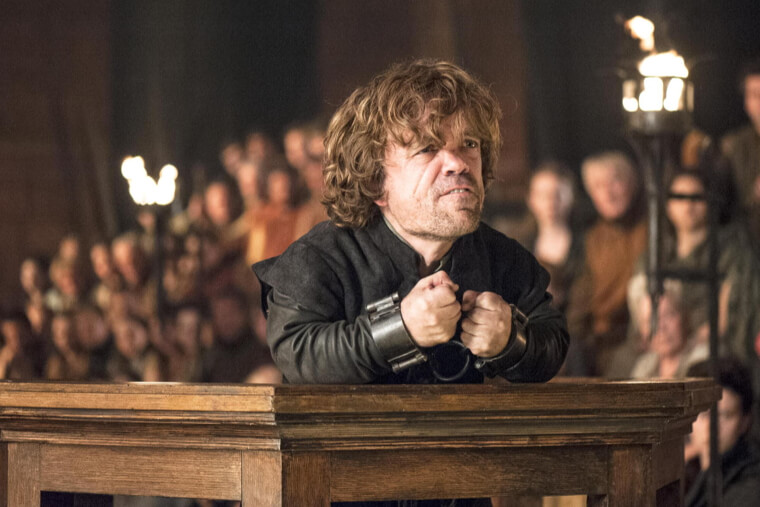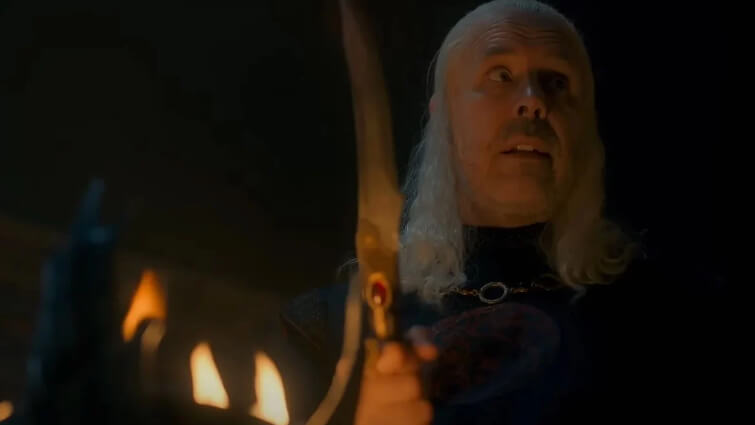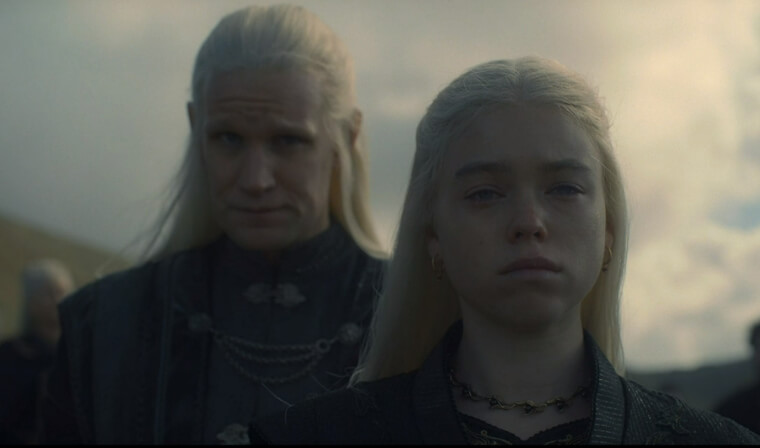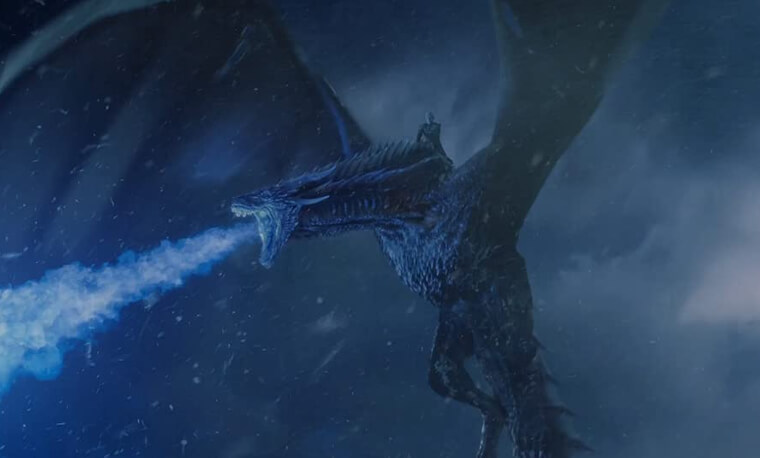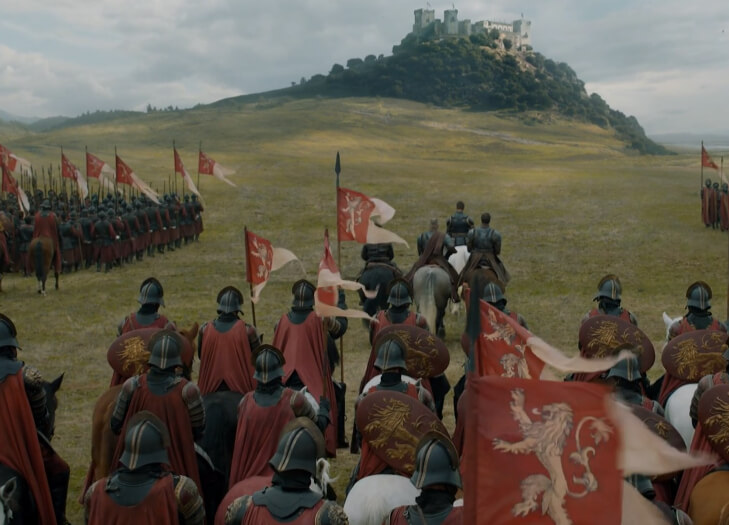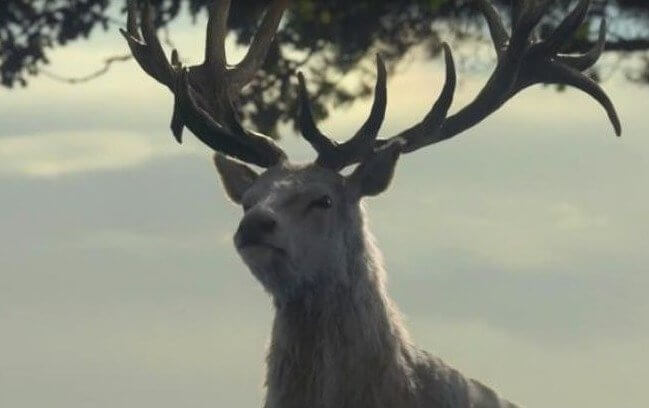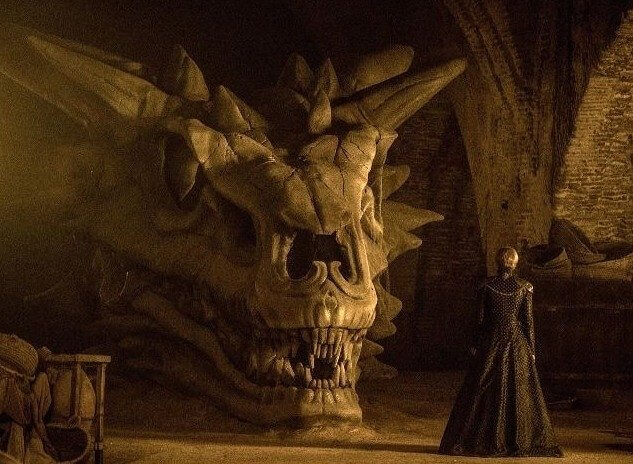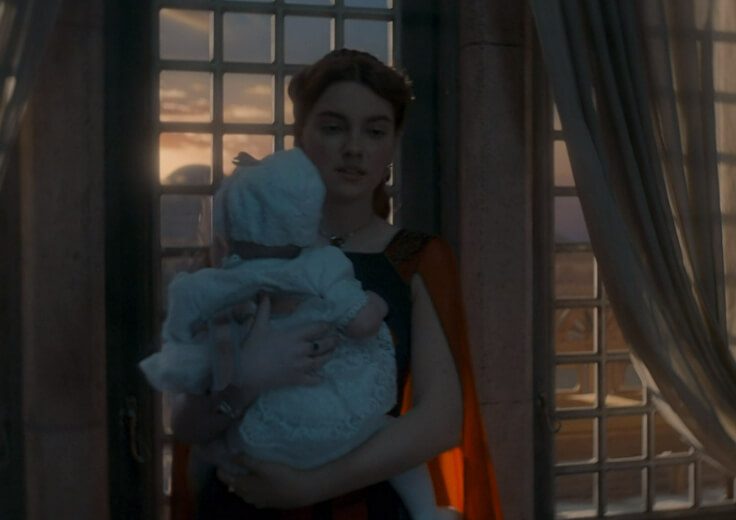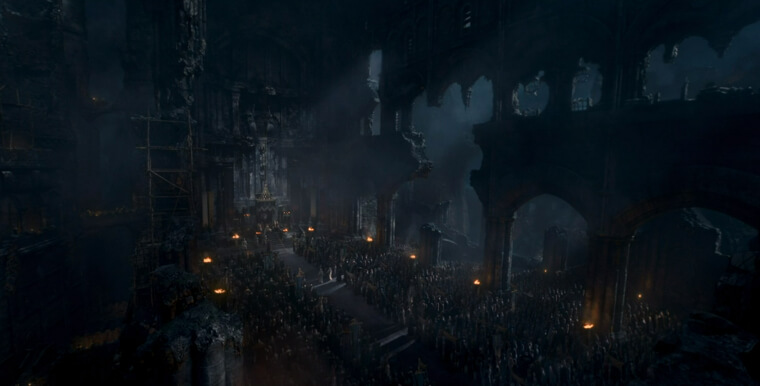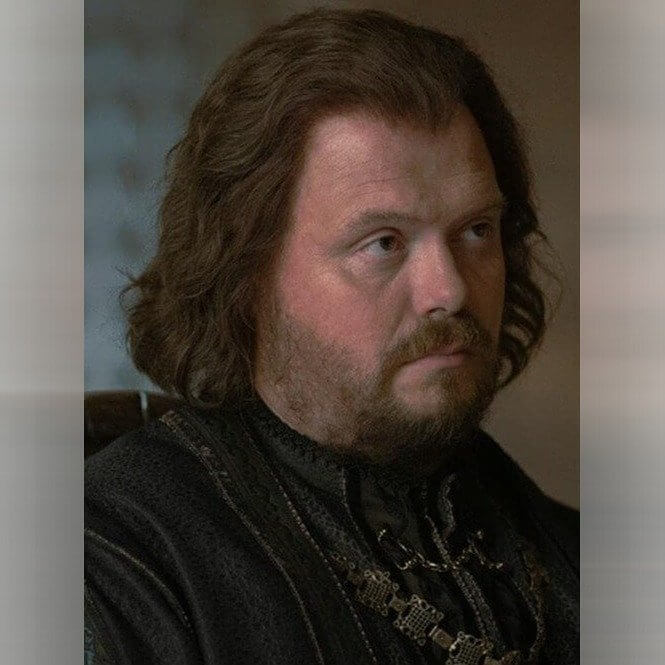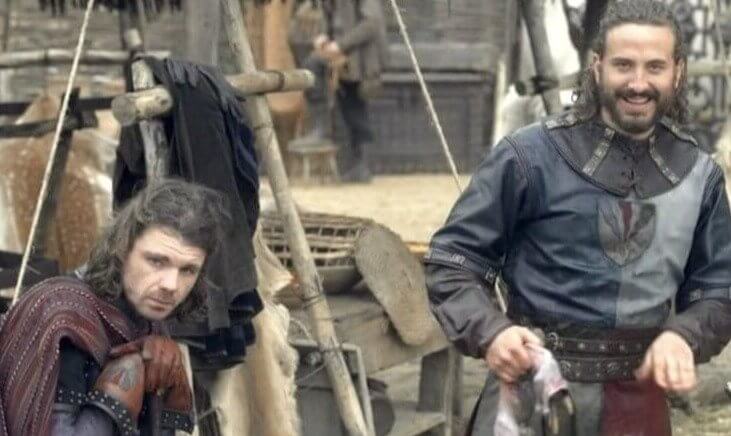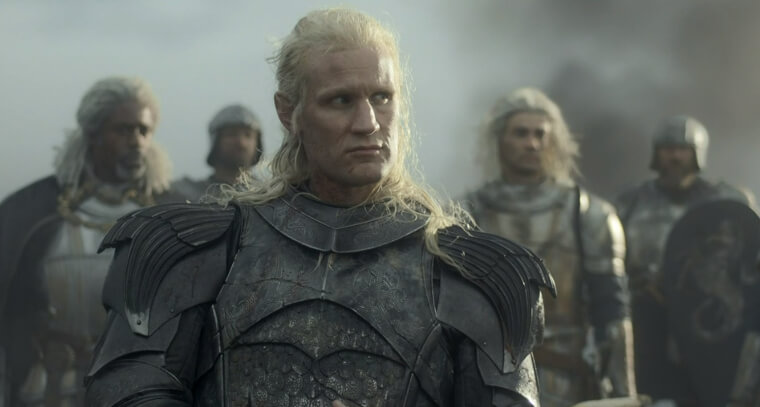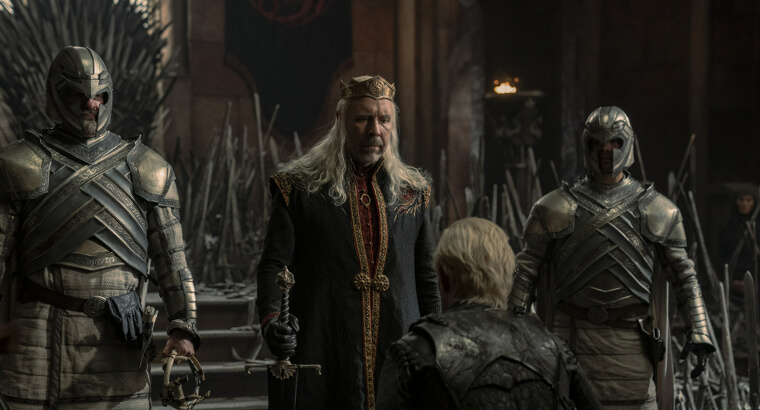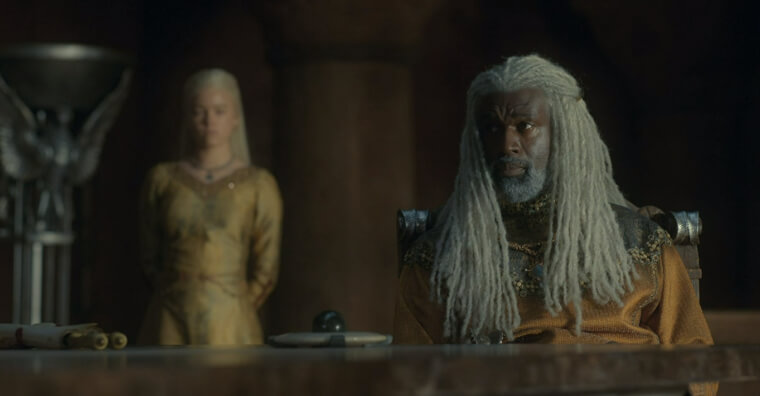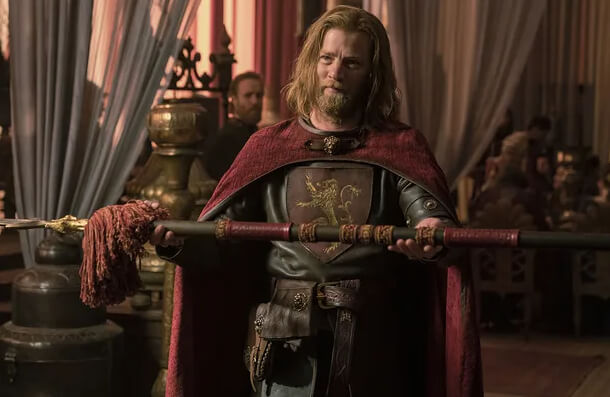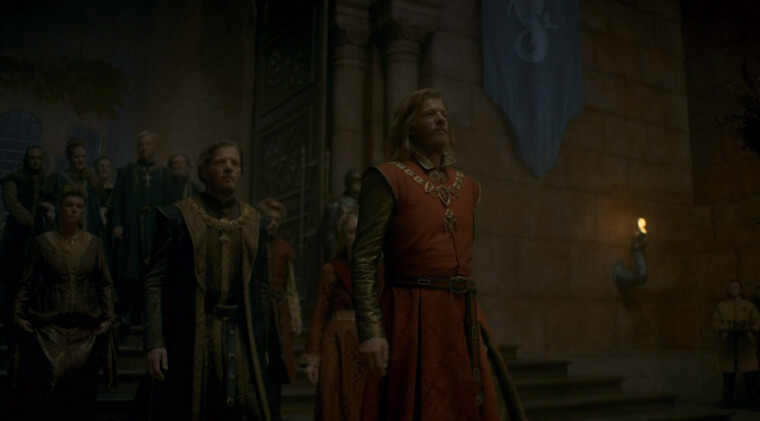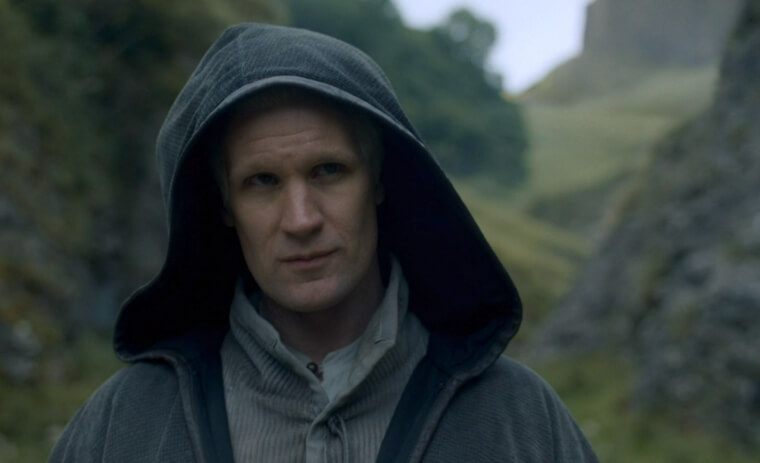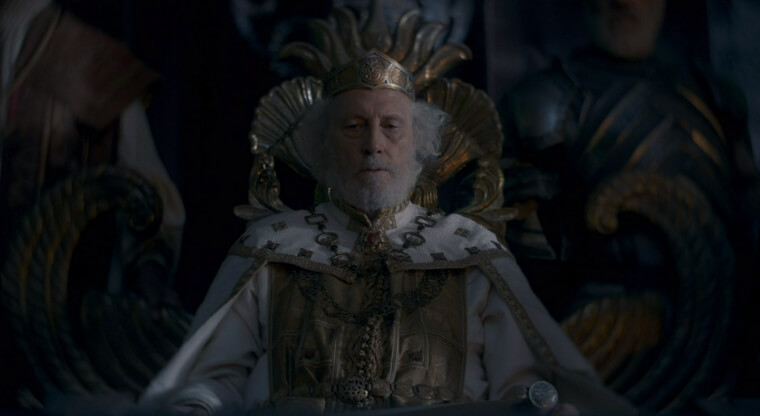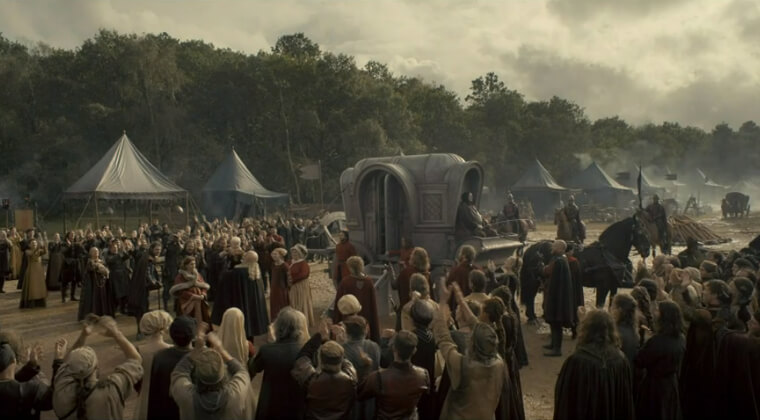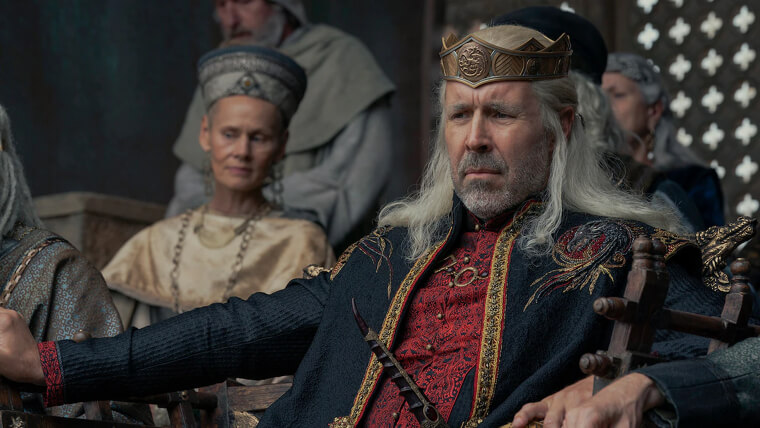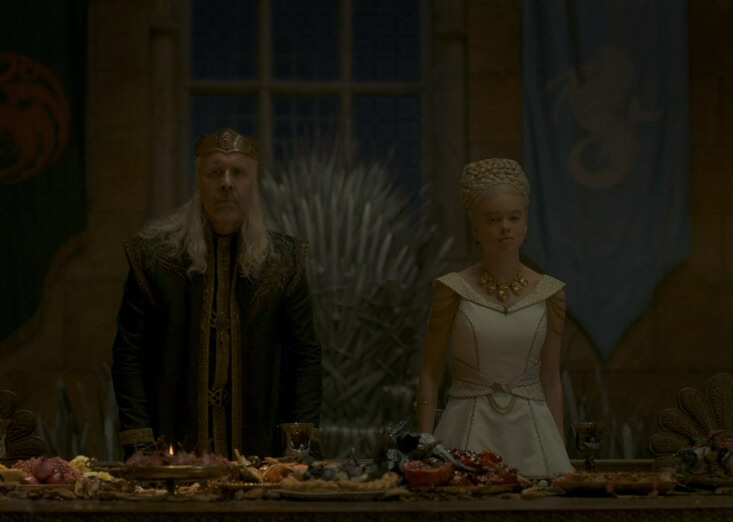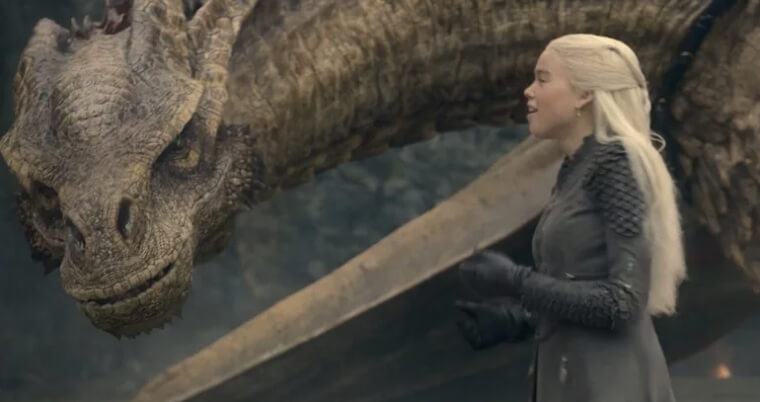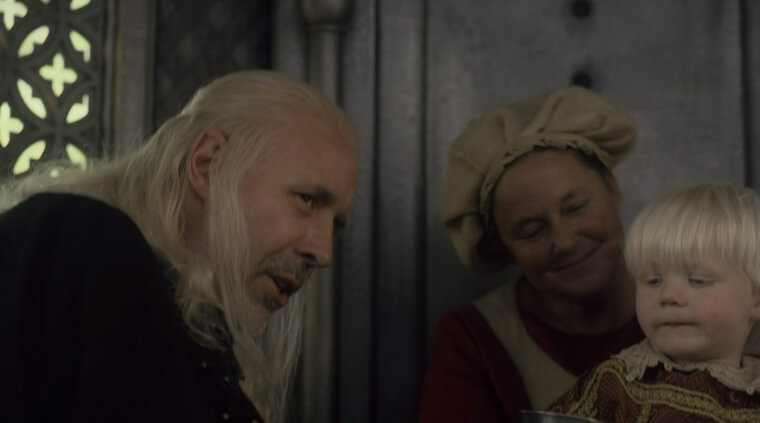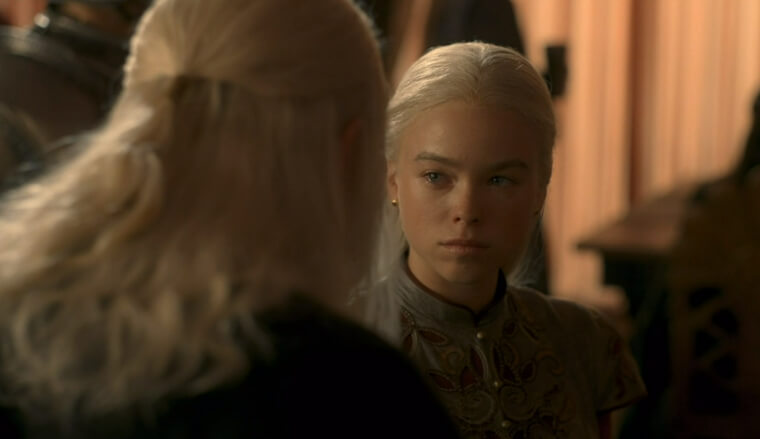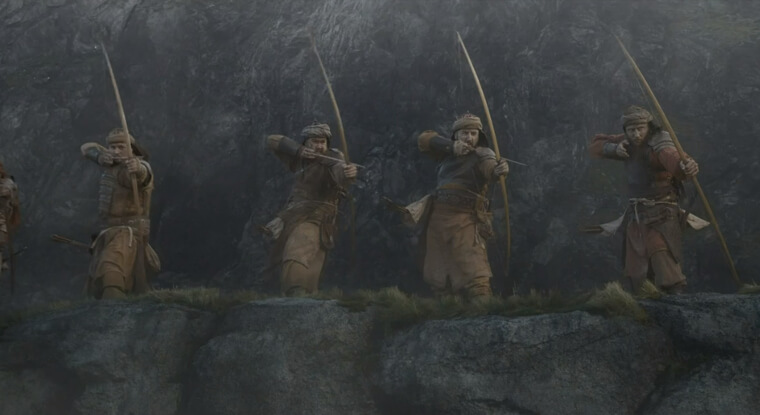This article was originally published on Kueez
King Viserys' Wound Won't Seem to Heal
There's a moment in the first episode when King Viserys slices his finger on the Iron Throne. It seemed to be a minor cut at the start of the series but quickly became a severe health situation. The wound won't seem to heal, so he is told to have maggots eat away at his finger to prevent even further gangrene. A phrase recurring throughout the episode is "absence is a wound that will never heal."
This phrase represents the King's health condition and the loss of his wife and newborn baby, but what else could it be foreshadowing? In the latest episode, his arm is already gone, and his condition is worsening extremely fast.
What Happened Hundreds of Years Before Game of Thrones
The storyline of Aegon's vision or nightmare about the cold winds rising in the North that would result in terrible and evil darkness over the Seven Kingdoms was based on the fourth installment in George R. R. Martin's A Song of Ice and Fire series. Aegon refers explicitly to his prophetic vision as a disturbing dream that he names Song of Ice and Fire. And the only way to combat this is to fight back against the darkness with the help of dragons.
So now you know that Aegon the Conqueror predicted the rise of the White Walkers and saw the threat they posed to the world centuries before it happened in Game of Thrones. Makes perfect sense now, doesn't it?
The Song Rhaenyra Plays Is a Reference to Nymeria
Throughout episode three, Rhaenyra continuously listens to a song that seems to be a reference to Nymeria. The song has lyrics that read, "She fled with her ship and her people….Under the dragon's eye." This is too obvious as Nymeria is a princess who led her people after a war with the Valyrians. Rhaenyra was even filmed in the first episode with Alicent reading a story about Nymeria, so the connection seems evident.
Considering that there is another Game of Thrones spinoff in the works called 10,000 Ships which is about Nymeria and her journey, it's no surprise House of the Dragon mentions it.
The Connection Between Rhaenyra’s Costumes And The Colors of Her House
Costume choices play a vital role in the House of the Dragon universe. Considering the factions of House Targaryen are later even called by the colors of their clothing, there can be no mistakes in the costume designs. Specifically, the character Rhaenyra has some pretty essential details regarding her outfits. To showcase her innocence, costume designer Jany Temime wanted her to appear in yellows and beiges. But as her world changes, so do her looks.
Eventually, her costumes will become primarily black and red to represent the colors of her house. However, it happens gradually to move with the pace of the storyline.
This Might Be Why Crabfeeder Wears an Eerie Mask
At the end of season one, episode two of House of the Dragon, the creepy Crabfeeder seemed to be a real villain in the making. According to the books, the Crab Feeder hides burn marks on his skin with a strange mask he always wears. But if you look long enough, it resembles a disease called greyscale, that Game of Thrones fans might recognize. Could this be why the Crabfeeder is demented?
Though it's not explicitly mentioned in this series, greyscale does drive people crazy, which could be the real reason for the surprise of this villain.
Rhaenyra's Position as Cupbearer Foreshadowed Her Next Move
For years, King Viserys was set on having a son take over the throne; therefore, his daughter, Rhaenyra, was worried about her role in the kingdom. But her position as cupbearer could've been an indicator of how she would soon rise to importance. The cupbearer was historically an officer of high rank in royal courts, and soon after her time spent doing this, her father would summon her for another critical conversation.
The king apologized for wasting so many years and decided his daughter, Rhaenyra, was worthy of the crown. She eventually accepted although completely shocked, thinking the highest position she would hold would stop at the cupbearer.
The Queen That Never Was
House of the Dragon starts off with a bang, introducing a major crisis that the characters' are scrambling to figure out. King Jaehaerys summons a Great Council to discuss and figure out who should inherit the Iron Throne. His own children died, and he had no one to pass on the throne to. After much deliberation, the two prospects were Rhaenys and Viserys. Despite, Rhaenys being favored by most, the decision was made against her, and there's a reason why.
Rhaenys implied that misogyny was to blame for her missed opportunity to rule. This highlighted the difficulty women experienced with holding positions of power.
Queen Aemma Mentions the Mother of Dragons
Queen Aemma's pregnancy and the birthing scene were some of the most intense and emotional parts of House of the Dragon so far. With so much going on, it may have been hard to catch this almost hidden reference. In a moment of pain and exhaustion, Queen Aemma said, "After this miserable pregnancy, I wouldn't be surprised if I hatch an actual dragon" This quickly slipped the radar of many viewers, but it has a clear connection.
It was an apparent reference to Daenerys, known as the Mother of Dragons, after she had once emerged, unscathed, from fire while simultaneously holding baby dragons. Arguably, one of the most significant events in Game of Thrones, as dragons had been extinct for over a century then.
Promise Me, the Two Words No One Can Forget
Most avid viewers of the original series recognize that something feels familiar about the phrase "promise me." It's usually heard in significant scenarios like someone's last words in a sad or heartbreaking situation. It was heard when Lyanna Stark said it to her brother, Eddard Stark, after her son, Aegon, was born. Viserys also repeats this phrase when he tells Rhaenyra about Aegon's dream. Therefore, these two words carry a lot of weight.
Fans are sure these words will be heard and noticed throughout the series. So beware, something intense might be brewing when these words are spoken.
Tyrion’s Trial Is Already Referenced in House of the Dragon
In season four of Game of Thrones, episode six is all about the meaningless trial and prosecution of Tyrion Lannister and is named “the laws of Gods and men.” Ironically, House of the Dragon season one, episode three, references Lannister when a character says that exact phrase, “the laws of Gods and men.” So why exactly is this trial referenced in the new show, and what is the connection?
This show is riddled with creativity, and the clever use of the same phrase points toward the ineffectiveness of laws in their universe. Many characters experience moments of uncertainty that no law can help with.
This Dagger Made an Appearance in Both of Shows
This weapon is prominent in both House of the Dragon and Game of Thrones. It's King Viserys' Valyring steel dagger, one of the most important weapons in the Seven Kingdoms. It had been passed down for years by many different owners, but it was recently revealed to be a royal Targaryen heirloom. The king eventually gave the sword to his daughter, Rhaenyra. Who knew that a weapon could hold so much significance?
This season reveals the actual owners despite all the people who owned this sword before. It was King Viserys and now, Rhaenyra Targaryen's legacy to protect.
The Word Dracarys Has Been Uttered for Centuries
Daenerys Targaryen is a powerful and even intimidating character at times. She also has a special connection to fire, appearing as if she has immunity from being burnt. When she sees her enemies, she uses this to her advantage and has a straightforward tactic to incinerate them. By uttering the High Valyrian word, Dracarys, she can set anyone she desires on fire. This word was also used throughout Game of Thrones, so the emergence is no surprise.
After Queen Aemma and her son Baelon passed away, Rhaenyra used this order to light their funeral pyre. This word carries importance and has been used throughout Targaryen history.
Unlike in GOT, Dragons Are Sacred In This Series
Throughout Game of Thrones, dragons were scary and an eerie reminder of what the world once was. Specifically in "The Bells" episode when Daenerys rode off on a dragon, scorching the city in fire and burning it all down. People were rightfully scared at the sight of a dragon, but in this series, they mean something very different. House of the Dragon shows another time when people lived relatively at peace.
Nobody ran away when a dragon was present or feared for their lives; they were simply a part of society. The parallel between the two shows and the way dragons are perceived is very entertaining.
Lord Jason Names Key Locations From Game of Thrones
You must be reading this if you watched the series; otherwise, spoiler alert! Anyway, in Lord Jason's attempt to flirt and gain the interest of Rhaenyra Targaryen, he name-drops some locations that only true fans of these series will recognize from, of course, no other than, Game of Thrones. He talks about Casterly Rock and the view of the Wall and the Sunset Sea, all prominent locations that played vital roles in the Game of Thrones ending.
There will undoubtedly be more easter eggs dropped throughout the continuation of this series. But what else was gathered? Keep reading to find out if you missed something.
The Sudden Appearance of a Rare White Animal Is Intentional
The ultimate easter egg is the appearance of the white hart stag in episode three of House of the Dragon. In Game of Thrones season eight, episode five, "The Bells," Arya Stark sees a white horse, and in this series, Rhaenyra sees a white hart as she considers her royal future. Both of them have a distaste for marriage and reference Nymeria often, so there is a clear significance to this mystical animal and the connection between these characters.
These small details could easily be missed if you don't pay close attention. The foreshadowing continues, and the episodes overflow with symbolism, so what else could pop up?
The Skull of the Largest Dragon Was on Display
The significance of having this dragon's skull on display is no accident. Game of Thrones fans and book readers may recognize this skull as belonging to Balerion the Black Dread, the enormous dragon. In fact, Balerion belonged to Aegon the Conqueror, Maegor the Cruel, and finally to King Viserys. Princess Rhaenyra assumes her family has had influence over the Kingdoms because they can control these beasts, but her father feels differently.
When King Viserys hears his daughter say this, he quickly shares that the dragons are as fantastic as they are terrible.
The Birthing Bed Is the Woman's Battlefield
In the opening episode of House of the Dragon, you witness the would-be Prince's violent and bloody birth and death. Ironically, Queen Aemma tells her daughter Rhaenyra that carrying and birthing a child feels like war for a woman's body. This episode starts strong by showing the brutal death of the Queen and her newborn son's lifeless body. But it wouldn't be a Game of Thrones show without buckets of blood and tragedy.
Their deaths remind them of their own mortality and roles in the kingdom. After witnessing her mother and brother's death, it ignites something in Rhaenyra that will surely change her character arc.
The Dragonpit Remains Untouched
The Dragonpit shown throughout this series is the same as the one you see throughout the show, Game of Thrones. However, then, it was in shambles, completely destroyed. However, it carries a very different weight in the prequel. House of the Dragon shows the King's Landing at a time of peace, and the Dragonpit is still intact and in use. However, if you connect the dots between these two shows, it only means one thing.
The Dragonpit must have fallen into disrepair while the Targaryens still occupied the throne, which may be shown later in the series.
Lyonel Strong Predicts the Future
King Viserys has a hard time finding reliable people who he can trust. Many have their own best interests in mind and would gladly sway the King the wrong way if it meant they could gain something from it. But there is one rare man who sticks to his morals and never tries to trick the King. His name is Lyonel Strong, the only person to give good advice that eventually foreshadows a certain marriage.
In earlier episodes, he suggests Rhaenyra should marry Laenor so they can form an alliance. Ironically his own son becomes her rumored lover.
Did Anyone Notice What's Hanging in Driftmark Throne Room
After the infamous terrifying Crabfeeder was killed, his mask was taken to a special place. Do you know the castle at Driftmark that homes Lord Corlys Velaryon and Princess Rhaenys? Well, it's become the latest decor item added to the walls of their castle! In fact, Lord Corlys Velaryon is known for displaying his trophies and souvenirs from traveling and wars, and this is just another notch on his belt. Although Daemon Targaryen killed the Crabfeeder, they benefit significantly from his murder.

Though it may seem creepy or intimidating, the Crabfeeder's mask will remain hung up, serving as a comforting reminder of their strength and power to any guest who enters their castle.
Episode Three Drops Major Easter Eggs in Reference to the Books
In season one, episode three of House of the Dragon, you meet some brand new characters. They are Lyonel Strong’s sons known as Larys Clubfoot & Harwin Breakbones. In the book, Larys had an injured foot that was twisted at birth which is why he was nicknamed Larys Clubfoot. Harwin Breakbones was also mentioned in the book, receiving his nickname because of his impressive strength. They don’t appear in the original series but are very important in the prequel.
As if Rhaenyra Targaryen's life wasn't already complicated enough, Lyonel Strong's sons will play a dominant role in her storyline.
Read the Books and the Gold Cloaks' Brutality Won't Surprise You
House of the Dragon is no stranger to violence, and some scenes can get pretty brutal. Particularly when Prince Daemon's Gold Cloaks tries to rid King's Landing of all its criminal activity and introduces extrajudicial torture and death as a way to scare people from partaking in it. He encourages his men to enforce this by violently tormenting people in public, like cutting off their hands and more. Now, this would only scare the city dwellers, right?
According to the book, and so far in the series, these brutal tactics actually gain Daemon more popularity. His claims about keeping his city safe are strong, and only time will tell if people continue to agree with his logic.
The King's Model Room Could Be a Warning
Throughout Season One, King Viserys can be seen building an elaborate model of Valyria, the home of the Targaryens. He continuously refers to the Doom of Valyria. Many characters are caught speaking about this as if it was something inevitable like a natural disaster. But there are substantial implications that the Doom was a collapse brought about by the kingdom and inhabitants of Valyria. Suddenly there's a very symbolic moment between King Viserys and Alicent, a young lady sent to seduce him.
Alicent asks King Viserys what he thinks regarding Valyria being at its peak or fall. Suddenly he drops and breaks a figurine of a dragon, and the eerie feeling lingers in the air for a few moments.
George Martin Gave the Show His Approval Only if It Had These Things
George R.R. Martin wrote all of the books that Game of Thrones and, of course, House of the Dragon are based on. Before this show could even go into production, it needed his stamp of approval. He not only wrote the original series but helped produce and create the show that you know today. However, he had three specific requests that needed to happen for him to approve and work on the show officially.
According to insiders, George insisted on this series including many more colorful dragons, an emphasis on heraldry, and an explanation on the story of King Jaehaerys Targaryen II.
A Game of Thrones Actor Is Brought Back in This Show
The House of the Dragon series introduces a new set of twins to the storyline, the Lannister twins. It's not shocking that some of the actors from the original series, Game of Thrones, appear in new roles for this show. Like Jefferson Hall, who currently plays Lord Jason Lannister of Casterly Rock and Tyland Lannister. However, fans might remember him for his small role as Ser Hugh of the Vale.
In order to tell the twins apart, they have very different appearances and personalities. But don't be fooled by his magnificent performance in this new series; it is, in fact, just one actor.
The Clothes Express the Characters' Allegiances
Fantasy shows usually have some of the most incredible and elaborate costumes in film and TV. House of the Dragon unquestionably showcases some fantastic costumes with attention to detail. The clothes that the characters wear are even color-coordinated. By paying attention to the colors of their clothes, you can tell which house a person belongs to and to whom they have allegiances. The costume designers definitely have a lot of work to do for each episode.
Not only do the clothes represent affiliations, but they were also a sign of wealth and prosperity for people of that time. They would walk around proud, decked out in their finest garbs.
Daemon Is Compared to One of the Most Menacing Kings
This series clearly shows that the people in Westeros aren't huge fans of Prince Daemon because he tends to use ruthless and violent tactics when fighting. One of his rivals is Otto Hightower, who suggests if Daemon were to take the throne, he would become like a second Maegor. Well, what is the small detail here that cannot be missed? Maegor is known to be one of the meanest kings ever.
If you know your Game of Thrones trivia, then you'd remember that Maegor the Cruel would wreak havoc on anyone who stood in his way. Being compared to this king is not a compliment but foreshadows something quite eerie.
The Biggest Event in the Universe
This spinoff is undoubtedly leaving fans excited and confused, waiting for more. It also may have already hinted at the cause of the Doom of Valyria, which was possibly one of the most critical events in Game of Thrones. House of the Dragon takes place centuries after Valyria has fallen but only now is it mentioned that the dragons may have had a hand in destroying Valyria. So what actually caused the Doom of Old Valyria?
Will fans finally have a more precise answer? It was initially understood to be from a natural cause like volcanoes erupting, but now it may be revealed it was solely because of the dragons.
A Trade Route Could Foreshadow War
Early on in the series, a council meeting takes place and there's a discussion of future parties, births, and even some scolding on showing up to meetings on time. When it comes to discussing trade routes, people seem uninterested. But Corlys Velaryon insists it's essential and won't let the subject go. He mentions that waterways are used for ships and valuable goods, and controlling those would be in their best interest, but how will this change their future?
Well, what bad can possibly come from this? The waterways' cities have some of the most oppressive tolls and pirates they've seen. Attempting to control these will be a dangerous feat that the show soon addresses.
Debate Over Who Will Take the Throne Leaves the King Suspicious
After Queen Aemma died, people were left wondering who would be next in line for King Viserys' throne. Many names are thrown around, and people feel the need to influence the king in his decision. He feels overwhelmed and compares the council to hungry crows crowding around a dead body, which is a direct nod to A Feast for Crows, the long-awaited fourth book in George R. R. Martin's A Song of Ice and Fire series.
So this little Easter Egg is, in its own way, a marketing tool, too. How neat!
The Infamous Iron Throne
Nothing was as iconic as the Iron Throne itself. Most kings' and queens' seats in history and movies were usually huge and luxurious. The seat of power in the Seven Kingdoms was threatening and apparently made of the swords of 1000 enemies. Therefore, sitting among it was bold in both the figurative and literal sense because of how cold, hard, and pointy it was. However, while sitting on the throne, King Viserys something happened that could indicate a significant change was coming.
There's a superstition that any ruler who sheds blood on the Iron Throne is cursed. Well, King Viserys was sitting on the Throne when he cut his hand on the armrest, which can only point toward his bleak future
Just Wait, More Dragons Are Coming
These iconic shows are known best for their fire-breathing mystical creatures, obviously! In Game of Thrones, there were only three dragons, and people were obsessed, but this new series definitely features way more. Considering the show's name, it would be weird if it didn't. Though they won't all be shown just yet, House of the Dragon is said to have a whopping seventeen different dragons that you'll get to know closely!
Miguel Sapochnik, one of the show's co-showrunner, revealed that the first season would only show nine of the seventeen dragons. But who knows? Maybe as the series progresses, even more, will come out of the darkness.
A Main Plot of Game of Thrones Makes Its Way Into Episode One
One of the most essential points consistently brought up throughout Game of Thrones is the concern about the cold wind rising in the North. So how does this now present itself in House of the Dragon? In the first episode, King Viserys Targaryen references it even though this series is based on parts of the fantasy book Fire & Blood and is set around two hundred years before the events of Game of Thrones.
It turns out Aegon had an apocalyptic vision that showed the end of humankind near. He knew only a Targaryen with a dragon could save humanity, revealing why he set out on the conquest in the first place.
Conquering the Wild Boar
There is a moment in the series where Rhaenyra runs into the woods and suddenly finds herself in a scary head-on situation with a boar. It charges at her and begins attacking, but she doesn't hesitate and swiftly takes action, and she slaughters the animal without blinking an eye. But there happens to be one other incident in which a character brutally encounters a boar, and maybe there is some significance to it.
King Robert Baratheon encountered a boar while hunting, and it began attacking him, resulting in an injury so bad it eventually led to his death. Quite the contrary to Rhaenyra’s strength, which showcases her intense hunting abilities.
The Battle Parallels Are Uncanny
The House of the Dragon’s first big battle episode heavily resembles battles of the beloved Game of Thrones. The prequel series is undoubtedly as action-packed as the original and seems it will not be lacking in any sense of violence or gore. Specifically, The War for the Stepstones looks similar to the Battle Of The Bastards. From how the scenes were filmed to the motives behind the men in the battles, it is all alike.
In both shows, these battles consisted of the characters trying to get the army to face off against one man but ultimately being stopped before they could do so.

